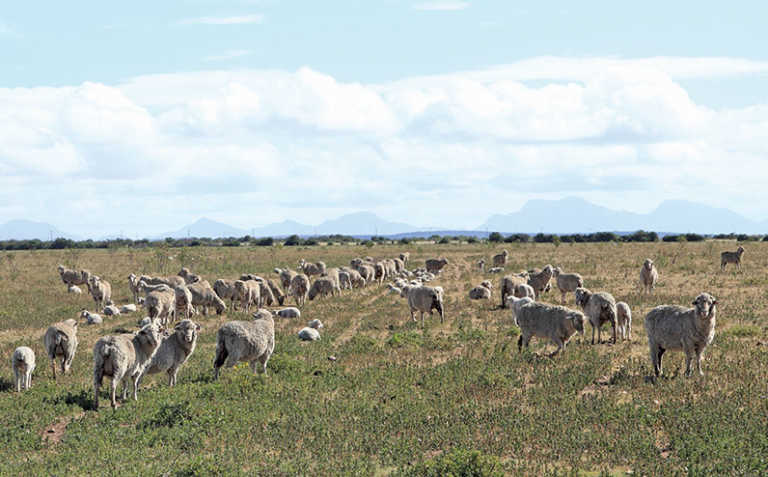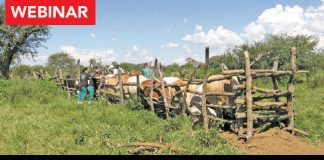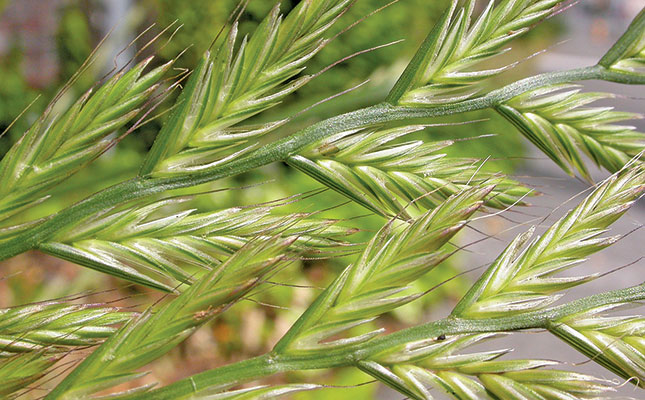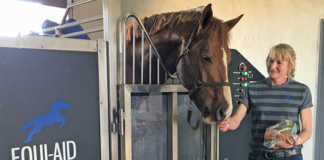
Photo: Glenneis Kriel
Vleesbaai in the Western Cape is located exactly between the summer and winter rainfall areas, and it is here that Johan Müller produces Merino wool on Witteklip and Ouland.
The location of his farms means that, in addition to receiving a mere 250mm to 400mm of rain a year, Müller never knows whether the rain will come in summer or winter, or be spread throughout the year.
READ Afrino sheep excels in producing mutton and wool on the veld
These harsh conditions led to his decision to farm medium-framed Merinos that weigh 50kg to 55kg, rather than today’s industry standard of 80kg.
“Instead of large-framed sheep, bred to thrive under good production conditions, I need hardy sheep that will keep their condition on sourveld,” he says.
Müller got the idea to farm with medium-framed Merinos in the 1990s, while visiting the Picker family in New South Wales, Australia. They had long held the world record
for the highest-priced bale of wool.
Back then, the Pickers had more than 14 000 sheep that produced wool of 13 to 15 microns. As fineness of wool and larger sheep size correlate negatively with each other, their sheep weighed only 40kg to 50kg each.
“The visit confirmed my suspicion that higher wool earnings thanks to fine wool production could offset lower meat and wool yields from medium-framed sheep,” he says.
The advantages
Having medium-framed sheep allows Müller to keep 1,3 sheep for what would have been one large-framed sheep, bringing his total flock to 2 000 stud ewes and 3 500 commercial ewes.
Merino has allowed him to improve wool fineness to between 16 and 18 microns, amongst the lowest figures in South Africa.
Most Merino producers generate about 60% of their income from meat and 40% from wool production. Shifting to medium-framed animals has resulted in Müller’s split being about 50:50 for the sheep kept on his Ouland farm and 40:60 for the sheep at Witteklip, which belongs to him and his brother, Heyns.
READ Join the Merino Sheep & Wool Experts Society
Two decades ago, ultra-fine wool was in such demand that farmers could make as much money with 2kg of 18-micron wool as they would have made with 8kg to 10kg of wool coarser than 22 microns.
Today, it is difficult to apply the same calculation, with coarser wool outperforming fine wool in some years, according to Müller.
At the time of writing, 18 microns sold for roughly R235/ kg, 19 microns for R225/ kg, 20 microns for R218/ kg, 21 microns for R216/ kg, 22 microns for R207/kg, and 23 microns for R171/kg.
Müller predicts, however, that prices for ultra-fine wool will pick up in coming years due to the growing demand for wool sportswear that can be worn directly against the skin by people taking part in mountain biking, skiing and other activities.
Genetics
The foundation for Müller’s flocks was laid a long time ago, as his family has been farming Merinos since the 1800s. In 1957, his father, Jurie, improved his flock substantially when he purchased an entire fine-wool Merino stud from the Uys family in Heidelberg. Müller has been building on this foundation since he joined the operation in 1984.
“Chris van Rooyen imported three of the world’s finest wool Merino rams back in the 1980s from the well-known Merryville stud in Australia. In 1988, to improve the fineness of our own stud, we bought three rams at the first production auction where these rams’ offspring became available. And later we bought another three. It was expensive but a great investment in the future of our fine-wool flock,” he recalls.
Between 1988 and 1991, Müller used artificial insemination to increase wool fineness as rapidly as possible, as it was expensive to buy rams with the genetics he was looking for.
Since then, he has used only natural breeding, with most of the rams being selected from his own stud. One or two rams are bought in each year to enlarge the gene pool and prevent inbreeding problems.
Forty rams are kept in the stud and six are replaced annually, with each being kept for about six years. Rams not incorporated in the stud are sold or used on the commercial flock.
Stud rams are sent for performance testing of wool quality and length, as buyers often want to know these figures. The data also helps Müller keep track of the genetic improvement of his flock and make better- informed selection decisions.
Animals are selected according to their build and body, as well as wool quality (fineness, length, colour and cleanness).
“I evaluate all the sheep during shearing time. I cull animals whose wool is coarser than 19 microns or doesn’t comply with my other production standards,” he says.
Reproduction
Müller implements two lambing seasons: one in March and the other in September.
“This allows me to use my rams twice a year and get by with half as many rams as I would have needed for one lambing season. It also helps spread my climatic risks,” he says.
Stud and commercial animals are treated fairly equally, as Müller says he does not have time to ‘spoon-feed’ any animal.
READ Follow these guidelines when dosing lambs
The sheep have to make do with lucerne and natural veld, consisting primarily of couch grass. Maize is bought in and given as flush feed two weeks before the ewes are placed with the rams. The animals also receive maize during the mating season to ensure they remain in good condition.
“I have 4 500ha of land, of which 200ha are planted to wheat and undersown with SA Standard lucerne each year,” he explains. “In the better lands that aren’t exposed to wind, I might plant wheat for two years, followed by canola, after which lucerne will be planted.
The lucerne is generally kept for up to 10 years before the soils are corrected and wheat is planted again.”
With its deep roots, lucerne flourishes during wet months, while the couch grass takes over during the drier times of the year.
The ewes are divided into groups of about 800, with roughly three rams being used for every 100 ewes. Young ewes that have not taken with a ram are diverted to another group, where either a Dormer or Suffolk ram is used on them to boost the weight of their offspring.
The latter are sheared and sold after weaning at six months. These ewes are kept until they are six years old.
“It’s strange. Many of these ewes would have been culled on another farm, but they tend to produce many twins after the first mishap. As farmers, we often forget that animals are not factories but sometimes need a break, especially when they’re not receiving the best feed,” he says.
Ewes are given maize six weeks before lambing and up to four months after lambing to ensure they have enough milk and are in good condition afterwards. They receive the maize only three times a week to prevent them from forming the habit of waiting for their feed at the gate.
The ewes are divided into smaller groups of 80 to 100 in a camp two weeks before lambing. Müller is opposed to what he calls the “fad of lambing cages”, seeing these as an unnatural and extremely time-consuming system that causes negative spin-offs over time.
“Lambing cages usually become fashionable during times like this, when lamb prices skyrocket. The truth, however, is that this system is not sustainable over the long run because it has a negative impact on the mothering qualities of the herd. The cages are also very difficult to keep clean. Over time there’s a build-up of parasites, which later results in high lamb mortalities,” he says.
His ewes have been selected over the years to stay with their lambs during the first three days after lambing.
The lambing percentage varies between 110% and 120% depending on the rainfall and the availability of feed, while the weaning percentage ranges from 90% to 110%. Rams and ewes not incorporated in the flock are sold when they are 11 to 12 months old.
Predation and stock theft
To prevent losses to predatory animals, donkeys are placed among some of the ewes with lambs, particularly where thick vegetative growth and cliffs occur.
“The trick with the donkeys is that they have to grow up with sheep, otherwise they’ll be useless,” says Müller.
READ Stock theft threatens growth in SA’s goat value chain
He also uses ‘night shepherds’, which are solar-powered reflectors tied to the horns of two ewes in every 100. “Jackal don’t like the reflectors, and they also scare off stock thieves by making them think someone is with the sheep,” he says.
Shearing
Müller sells his wool to BKB, while live animals are sold at production auctions or via GWK. Sheep are crutched when they are six months old, but only sheared once a year in February.
“My grandfather lost almost all his sheep in 1966 when, after a lengthy drought, 43mm of rain fell in two days. I therefore prefer a 12-month cycle. This means I never have to shear during winter, which is inevitable if you shear every eight months,” he says.
Email Johan Müller at [email protected].











